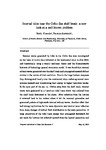Internal tides near the Celtic Sea shelf break: A new look at a well known problem
| dc.contributor.author | Vlasenko, Vasyl | |
| dc.contributor.author | Stashchuk, Nataliya | |
| dc.date.accessioned | 2016-03-23T16:28:46Z | |
| dc.date.available | 2016-03-23T16:28:46Z | |
| dc.date.issued | 2015-09 | |
| dc.identifier.issn | 0967-0637 | |
| dc.identifier.issn | 1879-0119 | |
| dc.identifier.uri | http://hdl.handle.net/10026.1/4404 | |
| dc.description.abstract |
Internal waves generated by tides in the Celtic Sea were investigated on the basis of in situ data collected at the continental slope in July 2012, and theoretically using a weakly nonlinear theory and the Massachusetts Institute of Technology general circulation model. It was found that internal solitary waves generated over the shelf break and propagated seaward did not survive in the course of their evolution. Due to the large bottom steepness they disintegrated locally over the continental slope radiating several wave systems seaward and transforming their energy to higher baroclinic modes. In the open part of the sea, i.e. 120. km away from the shelf break, internal waves were generated by a baroclinic tidal beam which was radiated from the shelf break downward to the abyss. After reflection from the bottom it returned back to the surface where it hit the seasonal pycnocline and generated packets of high-mode internal solitary waves. Another effect that had strong implications for the wave dynamics was internal wave reflection from sharp changes of vertical fluid stratification in the main pycnocline. A large proportion of the tidal beam energy that propagated downward did not reach the bottom but reflected upward from the layered pycnocline and returned back to the surface seasonal pycnocline where it generated some extra higher mode internal wave systems, including internal wave breathers. | |
| dc.format.extent | 24-36 | |
| dc.language | en | |
| dc.language.iso | en | |
| dc.publisher | Elsevier BV | |
| dc.subject | Baroclinic tides | |
| dc.subject | Internal solitary waves | |
| dc.subject | The Celtic Sea | |
| dc.title | Internal tides near the Celtic Sea shelf break: A new look at a well known problem | |
| dc.type | journal-article | |
| dc.type | Journal Article | |
| plymouth.author-url | https://www.webofscience.com/api/gateway?GWVersion=2&SrcApp=PARTNER_APP&SrcAuth=LinksAMR&KeyUT=WOS:000360871700003&DestLinkType=FullRecord&DestApp=ALL_WOS&UsrCustomerID=11bb513d99f797142bcfeffcc58ea008 | |
| plymouth.volume | 103 | |
| plymouth.publication-status | Published | |
| plymouth.journal | Deep Sea Research Part I: Oceanographic Research Papers | |
| dc.identifier.doi | 10.1016/j.dsr.2015.05.003 | |
| plymouth.organisational-group | /Plymouth | |
| plymouth.organisational-group | /Plymouth/Faculty of Science and Engineering | |
| plymouth.organisational-group | /Plymouth/Faculty of Science and Engineering/School of Biological and Marine Sciences | |
| plymouth.organisational-group | /Plymouth/REF 2021 Researchers by UoA | |
| plymouth.organisational-group | /Plymouth/REF 2021 Researchers by UoA/UoA07 Earth Systems and Environmental Sciences | |
| plymouth.organisational-group | /Plymouth/Research Groups | |
| plymouth.organisational-group | /Plymouth/Research Groups/Marine Institute | |
| plymouth.organisational-group | /Plymouth/Users by role | |
| plymouth.organisational-group | /Plymouth/Users by role/Academics | |
| dc.rights.embargodate | 2016-03-01 | |
| dc.identifier.eissn | 1879-0119 | |
| dc.rights.embargoperiod | 6 months | |
| rioxxterms.versionofrecord | 10.1016/j.dsr.2015.05.003 | |
| rioxxterms.licenseref.uri | http://www.rioxx.net/licenses/under-embargo-all-rights-reserved | |
| rioxxterms.type | Journal Article/Review | |
| plymouth.funder | FASTNEt - Fluxes Across the Sloping Topography of the North East Atlantic::NERC |


